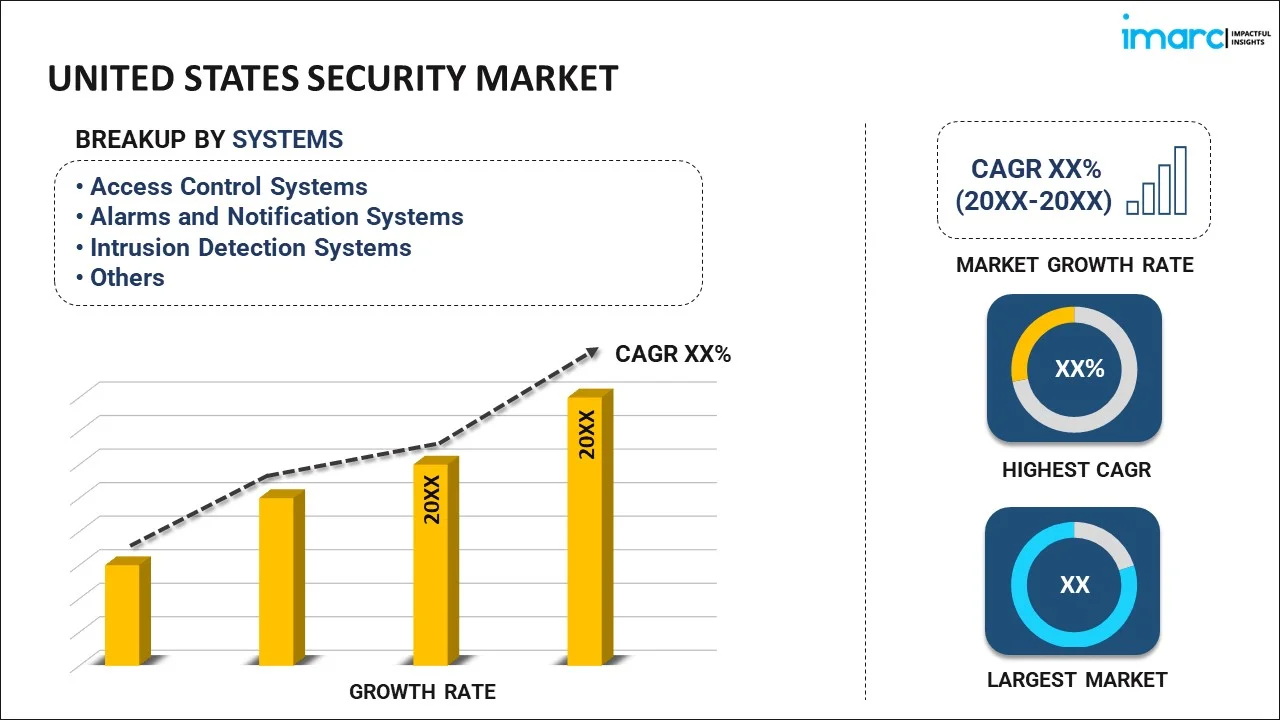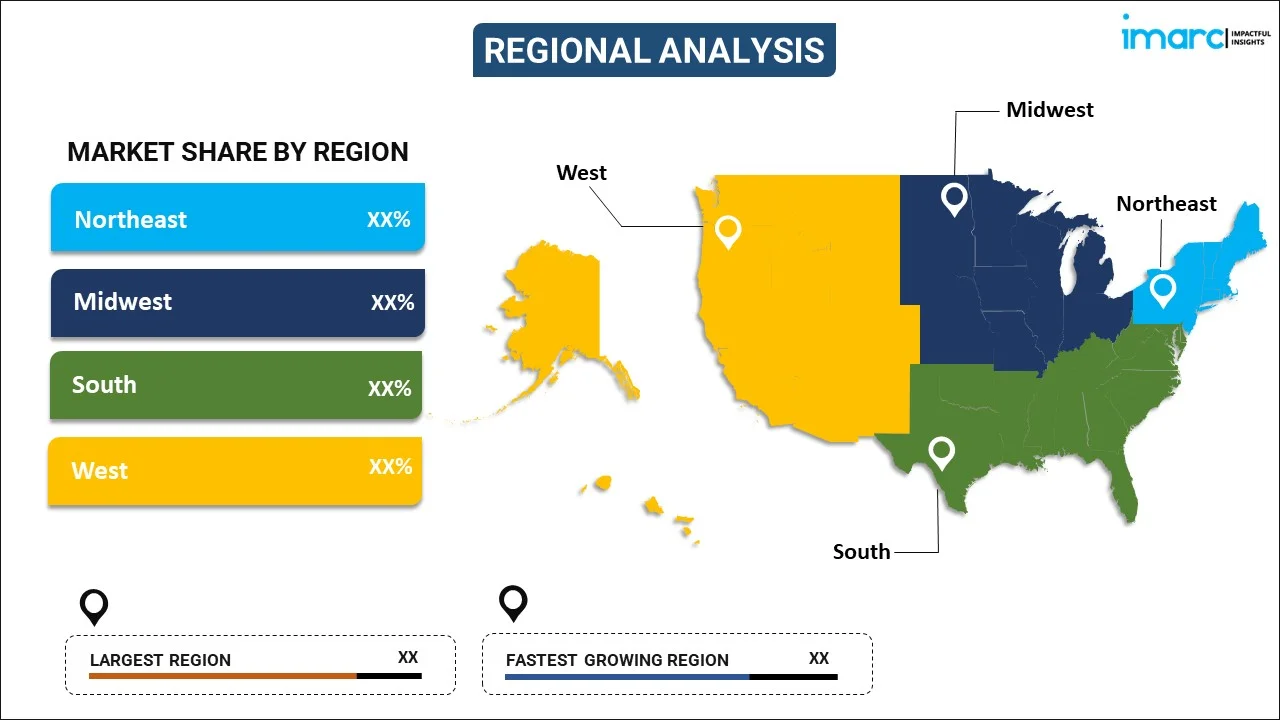
United States Security Market Report by System (Access Control Systems, Alarms and Notification Systems, Intrusion Detection Systems, Video Surveillance Systems, Barrier Systems, and Others), Service (System Integration and Consulting, Risk Assessment and Analysis, Managed Services, Maintenance and Support), End User (Government, Military and Defense, Transportation, Commercial, Industrial, and Others), and Region 2025-2033
Market Overview:
The United States security market size reached USD 40.1 Billion in 2024. Looking forward, IMARC Group expects the market to reach USD 78 Billion by 2033, exhibiting a growth rate (CAGR) of 7.7% during 2025-2033. The growing adoption in the military and defense sector to safeguard intelligence and military plans, rising demand for cost-effective and reliable solutions, and increasing employment to reduce the number of data breaches represent some of the key factors driving the market.
|
Report Attribute
|
Key Statistics
|
|---|---|
|
Base Year
|
2024 |
|
Forecast Years
|
2025-2033
|
|
Historical Years
|
2019-2024
|
| Market Size in 2024 | USD 40.1 Billion |
| Market Forecast in 2033 | USD 78 Billion |
| Market Growth Rate (2025-2033) | 7.7% |
Security prevents unauthorized access to assets, such as computers, networks, and data. It is reliable, cost-effective, time saving, and ensures privacy of sensitive information. It helps maintain the integrity and confidentiality of sensitive information by blocking access for hackers. It enhances the reputation and builds trust among customers, employees, and partners, and avoids legal penalties. It assists in ensuring the protection of assets, information, and individuals from potential threats and risks. It aids in safeguarding businesses and institutions from various forms of harm, such as physical, digital, and financial risks. Besides this, it mitigates potential losses and maintains the overall integrity of operations in an organization. As it maintains the smooth operation of day-to-day activities and safeguards essential assets, the demand for security is rising in the United States.
United States Security Market Trends:
At present, the increasing employment of security solutions to reduce the number of data breaches and hacking attempts represents one of the primary factors supporting the growth of the market in the US. In line with this, the growing demand for security due to the increasing number of complexities in business operations is offering a positive market outlook. Additionally, the rising employment of security in the military and defense sector to safeguard intelligence, military plans, technological advancements in military equipment and maintain confidentiality to combat enemies is propelling the growth of the market in the country. Apart from this, the increasing adoption of intrusion detection systems, encryption software, and vulnerability management tools to efficiently secure data, prevent theft, and avoid financial losses is impelling the growth of the market in the US. In addition, there is a rise in the demand for reliable, cost-effective, and quick security solutions in businesses. This, coupled with the increasing adoption of security among small-scale and large-scale enterprises to maintain the reputation of businesses, is contributing to the growth of the market in the US. Besides this, the growing demand for security to maintain transparency in organizations is positively influencing the market. Moreover, the increasing integration of artificial intelligence (AI) and machine learning (ML) in security solutions for intelligent threat detection, predictive analytics, and automated response systems is offering lucrative growth opportunities to industry investors in the United States. Furthermore, the rising adoption of security solutions to monitor and control access to the premises while ensuring the safety of employees and visitors is strengthening the growth of the market in the country.
United States Security Market Segmentation:
IMARC Group provides an analysis of the key trends in each segment of the United States security market report, along with forecasts at the country level for 2025-2033. Our report has categorized the market based on system, service, and end user.
System Insights:

- Access Control Systems
- Alarms and Notification Systems
- Intrusion Detection Systems
- Video Surveillance Systems
- Barrier Systems
- Others
The report has provided a detailed breakup and analysis of the market based on the system. This includes access control systems, alarms and notification systems, intrusion detection systems, video surveillance systems, barrier systems, and others.
Service Insights:
- System Integration and Consulting
- Risk Assessment and Analysis
- Managed Services
- Maintenance and Support
A detailed breakup and analysis of the market based on the service has also been provided in the report. This includes system integration and consulting, risk assessment and analysis, managed services, and maintenance and support.
End User Insights:
- Government
- Military and Defense
- Transportation
- Commercial
- Industrial
- Others
A detailed breakup and analysis of the market based on the end user has also been provided in the report. This includes government, military and defense, transportation, commercial, industrial, and others.
Regional Insights:

- Northeast
- Midwest
- South
- West
The report has also provided a comprehensive analysis of all the major regional markets, which include Northeast, Midwest, South, and West.
Competitive Landscape:
The report has also provided a comprehensive analysis of the competitive landscape in the United States security market. Competitive analysis such as market structure, key player positioning, top winning strategies, competitive dashboard, and company evaluation quadrant has been covered in the report. Also, detailed profiles of all major companies have been provided.
United States Security Report Coverage:
| Report Features | Details |
|---|---|
| Base Year of the Analysis | 2024 |
| Historical Period | 2019-2024 |
| Forecast Period | 2025-2033 |
| Units | Billion USD |
| Scope of the Report | Exploration of Historical and Forecast Trends, Industry Catalysts and Challenges, Segment-Wise Historical and Predictive Market Assessment:
|
| Systems Covered | Access Control Systems, Alarms and Notification Systems, Intrusion Detection Systems, Video Surveillance Systems, Barrier Systems, Others |
| Services Covered | System Integration and Consulting, Risk Assessment and Analysis, Managed Services, Maintenance and Support |
| End Users Covered | Government, Military and Defense, Transportation, Commercial, Industrial, Others |
| Regions Covered | Northeast, Midwest, South, West |
| Customization Scope | 10% Free Customization |
| Post-Sale Analyst Support | 10-12 Weeks |
| Delivery Format | PDF and Excel through Email (We can also provide the editable version of the report in PPT/Word format on special request) |
Key Questions Answered in This Report:
- How has the United States security market performed so far and how will it perform in the coming years?
- What has been the impact of COVID-19 on the United States security market?
- What is the breakup of the United States security market on the basis of system?
- What is the breakup of the United States security market on the basis of service?
- What is the breakup of the United States security market on the basis of end user?
- What are the various stages in the value chain of the United States security market?
- What are the key driving factors and challenges in the United States security market?
- What is the structure of the United States security market and who are the key players?
- What is the degree of competition in the United States security market?
Key Benefits for Stakeholders:
- IMARC’s report offers a comprehensive quantitative analysis of various market segments, historical and current market trends, market forecasts, and dynamics of the United States security market from 2019-2033.
- The research study provides the latest information on the market drivers, challenges, and opportunities in the United States security market.
- Porter's five forces analysis assist stakeholders in assessing the impact of new entrants, competitive rivalry, supplier power, buyer power, and the threat of substitution. It helps stakeholders to analyze the level of competition within the United States security industry and its attractiveness.
- Competitive landscape allows stakeholders to understand their competitive environment and provides an insight into the current positions of key players in the market.
Need more help?
- Speak to our experienced analysts for insights on the current market scenarios.
- Include additional segments and countries to customize the report as per your requirement.
- Gain an unparalleled competitive advantage in your domain by understanding how to utilize the report and positively impacting your operations and revenue.
- For further assistance, please connect with our analysts.
 Request Customization
Request Customization
 Speak to an Analyst
Speak to an Analyst
 Request Brochure
Request Brochure
 Inquire Before Buying
Inquire Before Buying




.webp)




.webp)












